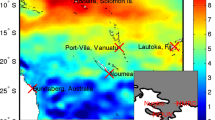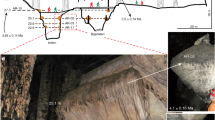Abstract
Mean annual sea level (MASL) data for 25 Greek stations were analyzed for the time period 1969–1982. The data from 4 of these were unacceptably poor, and the record of 3 stations showed unexplained step functions that were interpreted as errors. Relative MASL between stations showed crustal stability at 10 of the 18 useful stations. The standard deviation from the long-term average of these stations was ±1.8 cm. We conclude that if station records are carefully kept in this area crustal movements in excess of 5 cm can be detected by relative MASL. A comparison of MASL data with gravity changes measured in the Peloponnese and Central Greece suggests that vertical movements occurred along a gradient equal to or larger than the free air gradient. We conclude that the gravity network should be reoccupied frequently such that the non-tectonic effects to be determined from the probable observed gravity changes, and the tectonic vertical movements may be better understood. A co-seismic subsidence of about 5 cm is inferred to have taken place near Korinth during the 1981,M s =6.8, earthquake, which occurred 20 km N of this tide gauge (Posidonia). During 2.5 years before the 1968 Thessaloniki,M s =6.6, earthquake, sea level was lower than average suggesting possible crustal elevation of 3.6 cm at about 28 km epicentral distance. Because of the small amplitude of this change we are not certain that it represents crustal uplift. At station Myrina (on Limnos) a strong and consistent trend of subsidence accumulated a 15 cm change between 1975 and 1980. Chios showed a trend of emergence (total accumulation about +5 cm), while Volos showed a trend of subsidence (approximately −5 cm total). Kefalinia appears to have subsided about 10 cm during the data period. The six stations along the Hellenic arc plate boundary showed nearly constant MASL, suggesting that crustal stability existed there during the last 14 years.
We conclude that MASL data in Greece can be useful for understanding tectonic processes, especially if these data are gathered carefully and at numerous locations, and are cross-correlated to high precision repeat gravity measurements, and geodetic releveling. Also, MASL data on active volcanic islands have excellent potential for detecting uplift before future eruptions.
Similar content being viewed by others
References
Allen, C. R., Wyss, M., Brune, J. N., Grantz, A., andWallace, R. E. (1972),Displacements on the Imperial, Superstition Hills, and San Andreas faults caused by the Borrego Mountain earthquake of 7 April 1968, U.S. Geol. Survey Prof. Paper787, 87–104.
Balazs, E. I., andDouglas, B.C. (1979),Geodetic leveling and the sea level slope along the California coast, J. Geophys. Res.84, 6195–6206.
Burford, R. O., andHarsh, P. W. (1980),Slip on the San Andreas fault in Central California from alignment array surveys, Bull. Seism. Soc. Amer.70, 1233–1262.
Christodoulidis, D. C., andSmith, D. E. (1983),The tole of satellite laser ranging through the 1990s, NASA technical memo85104, 1–24.
Dewey, T. F., andSengör, A. M. (1979),Aegean and surrounding regions: complex multiplate and continuous tectonics in a convergent zone, Geol. Soc. Amer. Bull.90, 84–92.
Flemming, N. C. (1978),Holocene eustatic changes and coastal tectonics in the northeast Mediterranean: implications for models of crustal consumption, Philos. Trans. R. Soc. London, Ser. A,289, 1362, 405–458 and Appendix 1.
Fuis, G. S. (1982),Displacement of the Superstition Hills fault triggered by the earthquake, U.S. Geol. Survey Prof. Paper,1254, 145–154.
Georgadas, D., andLagios, E. (1982),Remeasurement of the national gravity base station network in the Peloponnese, Ann. Geol. Pays Hellen. Vol. 31, 136–145.
Hellenic Military Geographical Service (HMGS)Bulletin (1982),Consideration of the trigonometric network of the seismic area of the Alkyonides Islands, 23p.
Jackson, J. A., Gagnepain, J., Houseman, G., King, G. C. P., Papadimitriou, P., Soufleris, C., andVirieux, J. (1982),Seismicity, normal faulting, and the geomorphological development of the Gulf of Corinth (Greece): the Corinth earthquakes of February and March 1981, Earth Planet. Sci. Lett.57, 377–397.
Kelletat, D., Kowaleczyk, G., Schroeder, B., andWinter, K.-P. (1976),A synoptic view on the neotectonic development of the Peloponnesian coastal regions, Z. dt. geol. Ges.127, 447–465.
Kisslinger, C. (1975), Processes during the Matsushiro earthquake swarm as revealed by leveling, gravity, and spring-flow observations, Geology3, 57–62.
Lagios, E. (1984), A gravity network in Central Greece for secular gravity studies,Pure and Applied Geophys. (Submit.).
Lagios, E., Delibasis, N., Dracopoulos, J., andKouskouna, V. (1984), Gravimetric and seismological studies in the Atalanti Fault Zone,Proceed. 2nd Hell. Geol. Symp., Athens, May 1984 (in press).
Langbein, J. O., Linker, M. F., McGarr A., andSlater, L. E. (1982),Observation of strain accumulation across the San Andreas fault near Palmdale, California, using a two-colour geodimeter, Science218, 1217–1219.
LePichon, X., andAngelier, J. (1979),The Hellenic arc and trench system: a key to the neotectonic evolution of the eastern Mediterranean area. Tectonophysics60, 1/42.
Lisowski, M., andPrescott, W. H. (1981),Short-range distance measurements along the San Andreas system in Central California, 1975 to 1979, Bull. Seism. Soc. Amer.71, 1607–1624.
Lyness, D., andLagios, E. (1984),A microgravimetric network in East Central Greece-An area of potential seismic hazard, Geophys. J. R. astr. Soc.77, 875–882.
McKenzie, D. (1972),Active tectonics of the Mediterranean region, J. R. astr. Soc.30, 109–185.
McKenzie, D. (1978),Active tectonics of the Alpine-Himalayan belt: the Aegean Sea and surrounding regions, Geophys. J. R. astr. Soc.55, 217–254.
Okada, A., andKasahara, K. (1966),Postseismic subsidence of Awashima Island, Bull. Earthq. Res. Inst.44, 247–258.
Omori, F. (1913),On the recent sea level variation at the Italian and Austrian mareograph stations, and on the cause of the Messina-Reggio earthquake of 1908, Bull. Imperial Earthq. Investig. Committee5, 87–98.
Papazachos, B. C., andComninakis, P. E. (1971),Geophysical and tectonic features of the Aegean Arc, J. Geophys. Res.76, 8517–8533.
Pirazzoli, P. A., Thommeret, J., Thommeret, Y., Laborel, J., andMontaggioni, L. F. (1982),Crustal block movements from holocene shorelines: Crete and Antikythira (Greece), Tectonophysics86, 27–43.
Prescott, W. H., Lisowski, M., andSavage, J. C. (1981),Geodetic measurements of crustal deformation on the San Andreas, Hayward, and Calaveras faults near San Francisco, California, J. Geophys. Res.86, 10853–10869.
Savage, J. C., andHastie, L. M. (1966),Surface deformation associated with dip-slip faulting, J. Geophys. Res.71, 4897–4904.
Scholz, D. H., Sykes, L. R., andAggarwal, Y. P. (1973),Earthquake prediction: a physical basis, Science181, 803–809.
Shimizu, T. (1950),On the variation of the monthly mean sea level, Bull. Geogr. Surv. Invest.2, 1–16.
Tsumura, K. (1957),Study of change in the difference of monthly and daily mean sea levels between two stations, as an indicator of the vertical crustal deformation, ZisinII, 67–82.
Tsumura, K. (1971),Investigation of mean sea level and its variation along the coast of Japan (Part 2), J. Geodetic Soc. Japan16, 239–275.
Whitcomb, J. R., Franzen, W. O., Given, J. W., Pechmann, J. C., andRuff, L. J. (1980),Time-dependent gravity in southern California, May 1974 to April 1979, Geophys. Res.85, 4363–4373.
Wyss, M. (1976a),Local sea level changes before and after the Hyuganada, Japan earthquakes of 1961 and 1968, J. Geophys. Res.81, 5315–5321.
Wyss, M. (1976b),Local changes of sea level before large earthquakes in South America, Bull. Seism. Soc. Am.66, 903–914.
Wyss, M. (1981),Some earthquake precursors and their potential use in the Balkans, InProc. of the UNESCO seminar on Earthquake Prediction and Instrumentation, Thessaloniki, 9–26.
Author information
Authors and Affiliations
Rights and permissions
About this article
Cite this article
Lagios, E., Wyss, M. Estimates of vertical crustal movements along the coast of Greece, based on mean sea level data. PAGEOPH 121, 869–887 (1983). https://doi.org/10.1007/BF02590186
Received:
Revised:
Accepted:
Issue Date:
DOI: https://doi.org/10.1007/BF02590186




